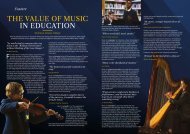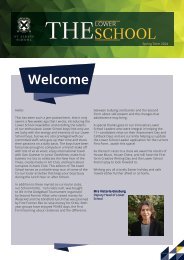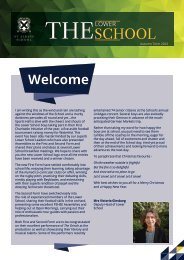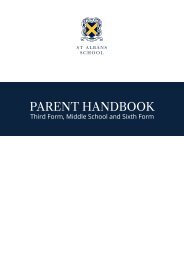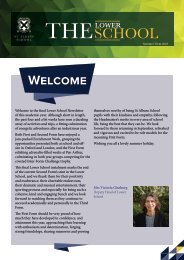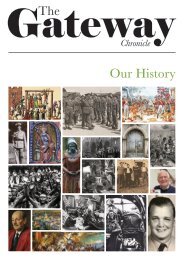Create successful ePaper yourself
Turn your PDF publications into a flip-book with our unique Google optimized e-Paper software.
33<br />
Hidden Voices<br />
The Place of Female Midwives<br />
in Early Modern England<br />
Many historians have pointed to the early modern<br />
period as a period of widespread professionalisation,<br />
where artisans and craftsman worked with their<br />
respective guilds to try and legitimise their own<br />
occupations, setting themselves apart as the sole<br />
provider of a particular service. This was especially<br />
the case within the world of medicine, with physicians,<br />
barber surgeons and apothecaries seeking to<br />
align themselves as certified medical practitioners.<br />
In doing so, these medical professionals began to<br />
tarnish the reputation and practises of unlicensed<br />
quacks and irregulars. The rise of gender history<br />
since the 1980s has resulted in a large scholarship<br />
surrounding the main victim of this campaign, the<br />
female midwife, who was gradually replaced by the<br />
male accoucheur. However, a revised analysis of this<br />
transition suggests that it should not necessarily be<br />
considered part of a misogynistic narrative. In fact,<br />
the continuing presence of female midwives, particularly<br />
during rural pregnancies, coupled with the<br />
unchanging level of agency granted to pregnant<br />
mothers, suggests that women still maintained a<br />
significant level of power during childbirth.<br />
Firstly, it is perhaps appropriate to outline the place<br />
of midwives within early modern society, so that<br />
their changing role during the period can be assessed.<br />
Typically, midwives cut across a wide social<br />
spectrum and because of this, their experience<br />
as practitioners was equally as diverse. Usually a<br />
mature, married or widowed woman with children<br />
of her own, the early-modern midwife gained her<br />
knowledge from attending the births of children<br />
within her community, and indeed, from her own<br />
experiences of childbirth. Before 1750, pregnancy<br />
and childbirth existed within a predominantly<br />
female-centric sphere; the delivery of the child and<br />
the ritual of lying-in was only attended by women<br />
from the community, known as gossips. Often<br />
lasting for around a month, the lying-in chamber<br />
thus became a sanctuary for female power; it housed<br />
a discourse that simply could not exist outside of<br />
those four walls. For many women this was a unique<br />
opportunity to separate themselves from the traditional<br />
patriarchal society, albeit temporarily, so it<br />
is no surprise that most women within a community<br />
became part of a mother’s pregnancy journey<br />
in some way. For example, a seventeenth-century<br />
ballad commented on the number of women attending<br />
a typical birth and the costs incurred for the<br />
husband; ‘Her Nurses weekly charge likewise, with<br />
many a Gossips feast: he well perceiv’d, when purse<br />
grew light, and emptied was his Chest’. Clearly for<br />
this husband, the extent of the gossip culture in<br />
early modern England was a little more than he had<br />
bargained for.<br />
However, there were times where the sanctuary of<br />
this female-only space was shattered by the presence<br />
of a male surgeon, who primarily attended<br />
to difficult births. This connection meant that the<br />
presence of a male practitioner within the birthing<br />
room therefore became synonymous with a difficult<br />
birth and the possibility of death from mother and<br />
child, so his presence was often met with fear and<br />
Above: a depiction of a woman ready<br />
to give birth from Jane Sharp’s ‘The<br />
Midwives Book’ (1671)<br />
anxiety. Yet, over<br />
the course of the<br />
early modern period,<br />
it became more<br />
common for men to<br />
be part of the process<br />
of childbirth;<br />
some men even entered<br />
the field permanently,<br />
becoming<br />
‘accoucheurs’, or<br />
‘man-midwives’.<br />
Feminist historians<br />
initially attributed<br />
this shift to changing<br />
provision that<br />
sought to eliminate<br />
women from<br />
medical practice,<br />
replacing women’s<br />
power with that of men. Sheena Sommers, for<br />
example, noted how the surgeon Louis Lapeyre<br />
characterised the female midwife as ‘the lowest<br />
class of human being’, and ‘an animal with nothing<br />
of the woman left’. Indeed, even the midwife Jane<br />
Sharp recognised these negative attitudes towards<br />
female midwives. Speaking in her Midwives Book<br />
(1671), the first book on this subject published by<br />
a woman, she stated that ‘some perhaps may think,<br />
that then it is not proper for women to be of this





